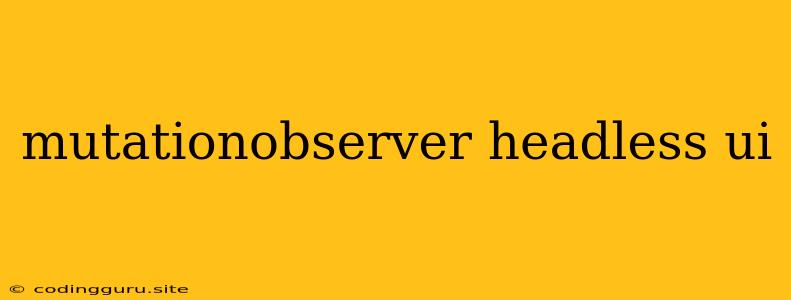Mastering MutationObserver and Headless UI for Dynamic UI Interactions
In the realm of modern web development, crafting dynamic user interfaces (UIs) that seamlessly respond to user actions and data updates is paramount. This is where the power of MutationObserver and Headless UI comes into play, enabling developers to build robust and interactive experiences.
Understanding MutationObserver: The Watchful Eye
MutationObserver is a powerful JavaScript API that allows you to monitor changes to the DOM (Document Object Model) tree. It provides a way to execute code whenever a mutation – an addition, deletion, or modification – occurs within a specified target node.
Why use MutationObserver?
- Real-time Updates: React to DOM changes as they happen, without the need for polling or frequent checks.
- Efficiency: Only trigger code execution when necessary, avoiding unnecessary computations.
- Event-Driven Development: Simplify complex UI interactions by decoupling event handling from DOM manipulation.
Headless UI: The Foundation for Accessible and Customizable Components
Headless UI is a collection of unstyled, accessible UI components built by the team behind Tailwind CSS. These components focus solely on the functionality and structure of UI elements, allowing you to seamlessly integrate them into your design system using your preferred styling approach.
Why choose Headless UI?
- Accessibility First: Headless UI components are built with accessibility in mind, ensuring a consistent and inclusive user experience.
- Customization Freedom: Design components to fit perfectly within your existing design language and brand guidelines.
- Component-Based Development: Leverage pre-built components for common UI patterns, reducing development time and effort.
Combining MutationObserver and Headless UI for Dynamic Interactions
The synergy between MutationObserver and Headless UI lies in their ability to create highly dynamic and interactive UI experiences. By using MutationObserver to monitor changes within a Headless UI component, you can trigger custom behavior based on these updates, creating a truly reactive experience.
Example: A Dynamic Menu with Headless UI and MutationObserver
Imagine a menu bar that expands on click, revealing additional options. Let's see how we can achieve this using Headless UI and MutationObserver:
import { Menu, Transition } from '@headlessui/react';
import { useState } from 'react';
function MyMenu() {
const [isExpanded, setIsExpanded] = useState(false);
const menuRef = useRef(null);
useEffect(() => {
const observer = new MutationObserver((mutations) => {
mutations.forEach((mutation) => {
if (mutation.type === 'attributes' && mutation.attributeName === 'aria-expanded') {
setIsExpanded(mutation.target.getAttribute('aria-expanded') === 'true');
}
});
});
observer.observe(menuRef.current, { attributes: true });
return () => {
observer.disconnect();
};
}, []);
return (
);
}
export default MyMenu;
In this example, we use the Menu component from Headless UI and a MutationObserver to observe changes in the aria-expanded attribute of the menu. When the aria-expanded attribute changes, the MutationObserver triggers the update of the isExpanded state variable, which, in turn, controls the visibility of the menu items.
Benefits of this Approach:
- Dynamically Responsive UI: The menu seamlessly expands and contracts in response to user interactions.
- Clean Code Structure: The logic for controlling the menu's state is neatly separated, leading to more maintainable code.
- Accessibility Compliance: Headless UI components are built with accessibility in mind, ensuring a consistent user experience for all.
Tips for Using MutationObserver and Headless UI Effectively
- Specificity is Key: Target specific DOM nodes to avoid unnecessary observation and code execution.
- Control Attribute Observation: Observe only the specific attributes that are relevant to your UI interaction.
- Use MutationObserver with Care: Avoid creating excessive observers, as they can impact performance.
- Leverage Headless UI's Features: Explore the various features and components within Headless UI to build complex and robust UI interactions.
Conclusion
MutationObserver and Headless UI are powerful tools that empower developers to create dynamic, accessible, and customizable web experiences. By combining the capabilities of these two technologies, you can craft interactive UIs that respond seamlessly to user actions and data updates.
By utilizing MutationObserver to monitor changes in the DOM and leveraging the functionality and accessibility of Headless UI components, you can elevate your web development projects to new heights of interactivity and responsiveness.
